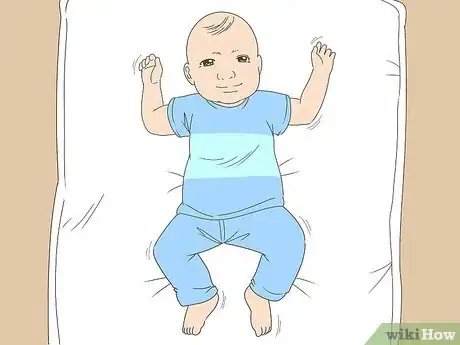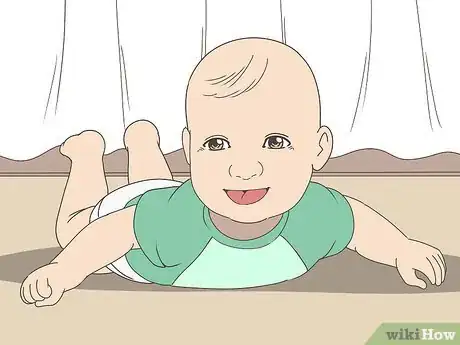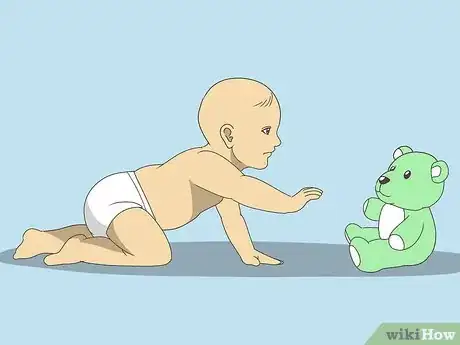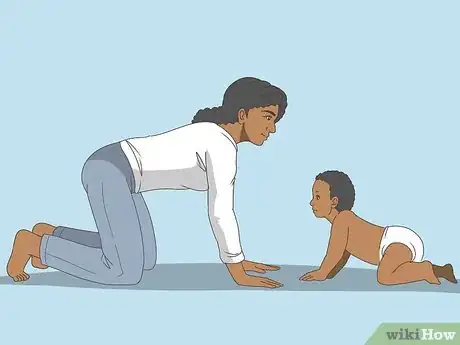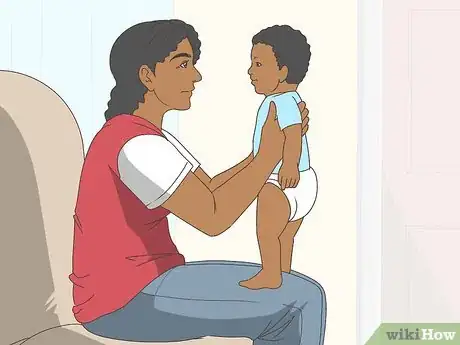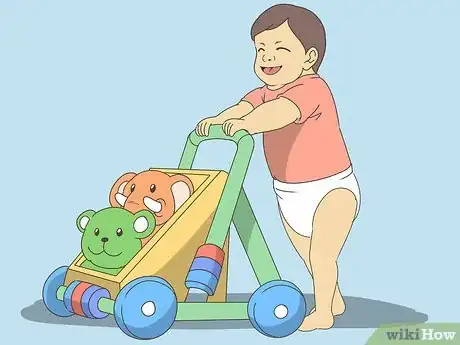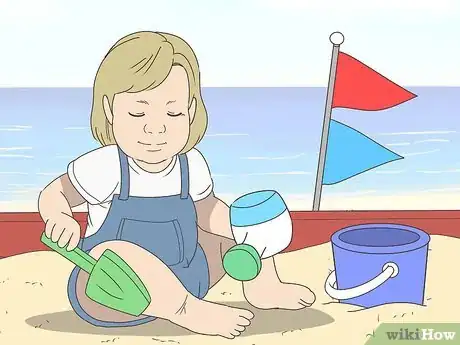This article was co-authored by Joel Warsh, MD and by wikiHow staff writer, Jessica Gibson. Dr. Joel Warsh is a board certified Pediatrician and the Owner & Founder of Integrative Pediatrics and Medicine in Los Angeles, California. With over a decade of experience, Dr. Warsh specializes in holistic and integrative medicine. He holds a Bachelor’s degree in Kinesiology and Health Sciences, a Master’s degree in Epidemiology and Community Health, and a Doctor of Medicine (MD) from Thomas Jefferson Medical College, where he was elected president of the Jefferson Pediatric Society. Dr. Warsh then completed his Pediatric Residency at Children’s Hospital of Los Angeles (CHLA), where he received the George Donnell Society Research Fellow.
There are 8 references cited in this article, which can be found at the bottom of the page.
This article has been viewed 19,968 times.
It's amazing how much babies grow and develop during their first year. You've probably seen baby calendars with iconic milestones like rolling over, sitting up, crawling, and walking—all gross motor skills that your baby should learn. If you or your baby's pediatrician is concerned that your infant needs a little encouragement with their gross motor skills, read on for fun suggestions to strengthen and motivate them.
Steps
Give your baby room to explore and move.
-
Set them down in a safe space so they can stretch and kick. If your baby is very young, unswaddle them and spread a blanket on the floor. Lay your baby down on their back so they can move their body. Once your baby can hold up their head, you can put them down on their side so they can practice rolling. The important thing is to give them room to move their body—don't automatically put them into a swing, baby seat, or bouncer where they're contained.[1] X Research source
- Always set your baby on a flat surface like a blanket on the floor that they won't roll off of.
- Kicking and waving their arms helps your baby strengthen their muscles.
- If your baby likes reaching for things, lay them on a baby mat that has toys hanging above them. Your baby won't be able to resist reaching up to play!
Lay your baby on their tummy for a few minutes.
-
Daily tummy time strengthens your baby's upper body muscles. Lay your baby down on their stomach and give them a minute to move, stretch, or rock from side to side. Keep tummy time short—plan on 1 minute for every month of your baby's age. For example, a 3-month old can do around 3 minutes while a 6-month old can handle around 6 minutes.[2] X Research source
- Don't leave your baby unattended during tummy time since they should only do it for about a minute.
- You can start doing tummy time once your baby has enough strength to lift up their own head.
- Some babies really don't like tummy time! If your baby fusses and cries, try making it more comfortable and fun. Lay your baby on a cushion and stay close by. Ring a bell or sing a song so they turn their body to look at you.
Sit behind your child and engage with them.
-
Sitting might not seem like a skill, but it actually strengthens their back and core muscles. To help your kiddo learn to balance, place them on the floor and sit behind them or put a big, soft toy behind them so they can lean back if they need to. Then, put toys in front of your baby or sing songs with them to let them know that you're still there.[3] X Research source
- Your baby may be a little wobbly at first—this is totally okay! With a little practice, your baby will become more confident and steady.
- To engage your baby, you might hold your hands out in front of them and do patty cake or the itsy bitsy spider.
Give your little one toys that make sounds.
-
Set out noisy toys so your baby has to shake or bang them. Babies are curious and constantly learning about the world around them. Stimulate their interest by putting out pots and pans. Then, give them wooden spoons so they can stretch their arms and bang the spoons on the pots. You can also put beads inside a sealable plastic container and encourage your baby to shake it back and forth.[4] X Research source
- Don't offer toys with small parts that your baby could choke on.
- These may not seem like serious gross motor exercises, but these noisy toys get your baby moving!
- Your baby will have more fun if you're playing with them. Occasionally, ask your baby to hand you a spoon or shaker. This way, they turn their body and stretch their arm out to you.
Set toys just out of your baby's reach.
-
Motivate your baby to stretch, crawl, or walk by putting a toy in front of them. If your baby dislikes tummy time or needs some encouragement to try walking, make it fun for them! Hold their favorite toy or a new item just out of their reach and say, "Come and get it!" If your baby doesn't try, move the toy a little closer and encourage them again.[5] X Expert Source

Board Certified Pediatrician Expert Interview. 2 February 2021.- Don't have any new toys? No worries—babies love checking out new things. You could set out measuring spoons or a stack of plastic measuring cups, for instance.
Crawl around on the floor with your kiddo.
-
Get down on the floor and model crawling behavior. Some babies start shuffling and dragging themselves along, but others need a little encouragement to crawl. Join your baby on the floor and crawl in front of them. Then, turn back to them and say something like, "Come on! Crawl to me!"
- If your baby is still hesitant to crawl, set up a little baby tunnel for them to crawl through and explore.
- Make crawling a game—set your baby down on their tummy and roll a ball in front of them to chase.
Hold your baby up by their arms and bounce them while they stand.
-
Pull your baby up into a standing position with their feet on your knees. While you hold them under their armpits, gently bounce your knees a few times. This helps them learn balance and strengthens their leg muscles.[6] X Research source
- Remember, your baby will have more chances at standing if they're not strapped into a stroller or sling all the time.
Give your baby a push toy to get them cruising.
-
Set out walking push toys or hold your baby's hands as they learn to walk. Once your baby has figured out standing, they may take a few cautious steps on their own. For a little extra support, give them a push toy that they walk behind. This is more helpful than strapping them into a walker with a seat. You can also walk with them! Hold both of their hands as they toddle so they feel stable.[7] X Research source
- Take off your baby's socks and let them walk barefoot. Shoes might feel awkward to learn in and your baby may slip in socks.
- If you've got stairs, put up a baby gate so your baby can't fall down them or climb up where they're not supposed to be. Close doors to rooms that you don't want your baby in, too.
Have a dance party to get your baby moving.
-
Turn on some music and start dancing! Exaggerate your gestures so your baby tries to mimic you. You might wiggle, shake, turn your body, clap your hands, stomp your feet, or wave scarves around. Switch up the music to find out what your baby likes. You'll probably see them start to bounce or twist as they get into the music, too![8] X Research source
- If your baby loves music, try playing games while you play music in the background. You sit on the floor and roll a ball back and forth, for instance.
Take your baby to parks or play spaces.
-
Let your baby scramble over play equipment once they're crawling or walking. Help your baby pick up more challenging skills by letting them explore different surfaces. Set them down to play around on the beach or crawl through the grass at the park. Give them the opportunity to practice walking up slopes or stairs, too.[9] X Research source
- Most playgrounds have a smaller area for babies and toddlers. These are usually away from bigger kids so your baby can play safely.
Warnings
- Always supervise your baby when they're playing or exploring. Never set them down on an elevated surface like a changing table and walk away.⧼thumbs_response⧽
You Might Also Like







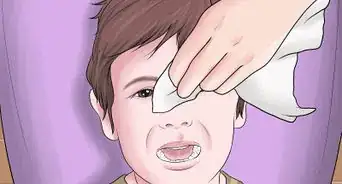



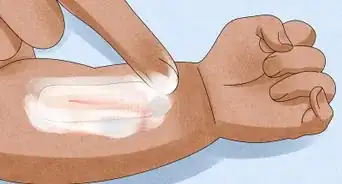


References
- ↑ http://www.essentialbaby.com.au/baby/development/6-12-months/how-to-encourage-your-babys-gross-motor-development-skills-20161027-gschtm
- ↑ https://www.nationwidechildrens.org/family-resources-education/700childrens/2020/07/4-ways-to-encourage-motor-development-in-babys-first-year
- ↑ https://www.spd.org.sg/how-to-enhance-your-childs-gross-motor-skills/
- ↑ https://raisingchildren.net.au/babies/play-learning/play-baby-development/movement-play-babies
- ↑ Joel Warsh, MD. Board Certified Pediatrician. Expert Interview. 2 February 2021.
- ↑ https://kidshealth.org/en/parents/move47m.html?WT.ac=ctg
- ↑ https://kidshealth.org/en/parents/move812m.html?WT.ac=ctg
- ↑ https://pages.uoregon.edu/asqstudy/asq/LearningActivities/Learning%20Activities.pdf
- ↑ http://www.essentialbaby.com.au/baby/development/6-12-months/how-to-encourage-your-babys-gross-motor-development-skills-20161027-gschtm
About This Article

